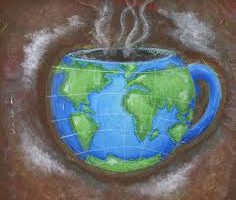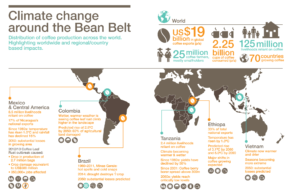Hope you take your coffee hot

Is iced coffee enough to combat global warming? Not likely. A warming climate is threatening Starbucks’ business model as coffee crop yields plummet around the globe.
You may be familiar with the famed Arabica bean—the fruit that when picked, roasted, and brewed, lifts people around the world out of bed and carries them through their days. An astounding 2.25 Billion cups of coffee are consumed every year globally. [1] The Arabica bean, along with its coffee bean siblings, is in danger as temperatures around the world continue to rise in the “Bean Belt.” Starbucks, the world’s biggest coffee seller, stands to lose the most. [2]
A recent report by the International Center for Tropical Agriculture indicates that if the global warming trend continues, 80 percent of lands in parts of Brazil and Central America where Arabica is grown will no longer be suitable by 2050. Over this same period, a global decline in suitable land is estimated at about 50%. [3] A recent study indicates that significant attention should be paid to the coffee growing regions of Brazil, Colombia, Costa Rica, Ethiopia, Tanzania and Kenya. Time series analyses have pointed to significant warming trends in these areas. [4]
Additionally, warmer weather means increases in the prevalence of diseases such as coffee rust and pests resulting in further declines in coffee yields. A 2011 report estimated hundreds of millions of dollars in losses of coffee beans just due to one pest: the coffee berry borer. [5]
What does this mean for coffee growers around the world? As yields decline, there will be tighter supply and subsequently higher prices for producers of coffee as well as the end consumer. This phenomenon has already been seen with brands including Maxwell House, Yuban, and Folgers as they have increased retail prices of certain products by 25%+ between 2010 and 2011 due to wholesale price increases. [6]
What has Starbucks done to date? Starbucks has long realized the threats to their business and their role as a major organization in contributing to global climate change. Since 2004, they have focused on aiding coffee farmers adapt growing practices to climate change and reducing their own emissions and impact on the environment.
For farmers, Starbucks has worked with Conservation International to “include climate-smart agricultural practices as part of their Coffee and Farmer Equity Practices.” [7] Starbucks spokeswoman Haley Drage stated, “We believe that with the proper vigilance, as well as a long term approach, we can help farmers manage the variables that come with [climate change].” Starbucks is also experimenting with these practices at a coffee farm they purchased in Costa Rica. Starbucks acknowledges, however, they are far from having all the answers. [8]
Starbucks is also doing its part as a global corporation to reduce its own footprint, however, it has experienced mixed results. They have focused on renewable energy, energy conservation, and climate adaption and mitigation efforts. Starbucks has also built stores to LEED standards and made significant purchases in renewables. Despite these efforts, Starbucks’ Greenhouse Gas Emissions have actually increased between 2013 and 2015. Starbucks cites strategic initiatives as the true underlying cause of this increase. For example, they have experienced net store growth over this period and have introduced heated foods to their menu, resulting in additional emissions from the ovens and refrigerators needed to deliver this new product segment. [7]
Starbucks is still far from a true solution in spite of the efforts they have made. As a large global company, they may need to make more significant investments in research of climate adapted growing practices to expedite the discovery of solutions to reverse the falling crop yield trend. As the largest player, they may be the only ones with enough resources to help find a solution in the near-term.
Additionally, as a result of Starbucks’ growing emissions, they may need to do more than look within their own business model to reduce their environmental footprint. A growing company and increasing emissions likely requires Starbucks to explore other offsetting measures whether that includes purchasing carbon credits or investing in measures to promote more biodiversity in the “Bean Belt.”
It will take more than a few million tall, sugar-free iced lattes to turn the tide for the coffee industry and set Starbucks up for continued success.
Word Count: 688
Sources:
[3] https://www.technologyreview.com/s/601404/starbucks-responds-to-climate-change-with-mixed-results/
[4] http://www.sciencedirect.com/science/article/pii/S0168192315000830
[8] http://www.starbucks.com/responsibility/environment/climate-change
Picture / Exhibit Sources (in order of appearance):
http://trinitynews.ie/climate-change-and-coffee/(cover)
http://www.starbucks.com/responsibility/environment/climate-change





It’s fascinating how Sbucks is working with the farmers to create more sustainable farming practices in the bean belt. What’s even more fascinating is that climate change has REAL implications on the coffee bean supply for Sbucks- the green initiative isn’t a publicity stunt but actually a potentially viable economic investment. What I’d like to know further is: what is the actual positive impact of Sbucks working with the farmers? Will this investment really help the farmers or is the bean belt doomed? Do we need government intervention as well as for-profit initiatives to counter the 50% degradation of farmland?
I wonder if the solution here isn’t for them to buy more coffee farms re: IKEA discussion in class. Rather than simply “working with farmers” to develop ways to grow coffee beans in warmer climates, could they bring in-house this research aspect since they’re already tackling it anyway? And could they use it as a way to generate more positive publicity, i.e., “we can do it better”?
While Starbucks has led the coffee industry in the investment of Fair Trade coffee, I am always surprised by how little they do to make their stores sustainable. Most coffee shops, offer patrons who are staying in the option to use reusable cups (i.e. ceramic mugs). Very few Starbucks locations in the United States offer this service. The store does provide a discount for patrons who use their own travel mugs, but it seems that any easy step towards in-store sustainability would be to offer customers a reusable mug.
I agree that Starbucks’ market position puts them in the unique position to lead the way for sustainability in the coffee business throughout its supply chain. I did not realize that their emissions each year have been climbing and I wonder if expanding into other product categories actually hurts them from a sustainability perspective. Earlier in 2016, there were rumors that Starbucks was evaluating strategic alternatives regarding the introduction of certain alcoholic beverages to its menu. At some point the market for coffee will be saturated and they will be without smaller coffee players to acquire — this begs the question of what adjacent markets they will pursue. Certainly they have the infrastructure and resources to pull it off, but if the expansion into new products is the strategy – what does that mean for climate change initiatives? Just as you mentioned here with new foods to their menu that ultimately increased emissions, this seems to be just another path to increased emissions.
Right now, Starbucks is aggressively focused on opening new stores in China and expanding its footprint in the emerging markets. This article addresses the relationship with farmers and sourcing the raw material to produce the coffee, but is there anything else the company can do as it looks to grow and expand outside the U.S.? I agree with some of the comments above, the consumer needs to be made more aware of this growing problem and an area of focus could be the actual cups and supplies they use to distribute their coffee.